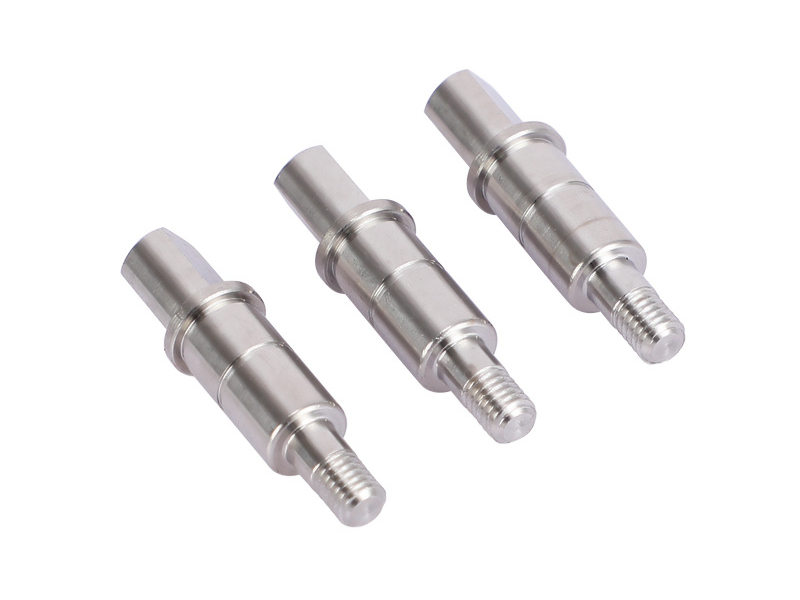Precision CNC Turning of Titanium Parts for Aerospace and Aviation Applications
Introduction
The Aerospace and Aviation industry demands materials that ensure optimal performance, reliability, and safety under extreme operating conditions. Titanium alloys, recognized for their superior strength-to-weight ratio, exceptional corrosion resistance, and high thermal stability, are increasingly employed in critical aerospace components such as turbine shafts, fasteners, and structural fittings.
High-precision CNC turning services are critical in manufacturing these complex titanium components, achieving stringent dimensional tolerances and superior surface finishes. CNC turning significantly boosts aviation components' reliability and operational longevity under severe aerodynamic and structural loads.
Titanium Alloy Materials
Material Performance Comparison
Titanium Alloy | Tensile Strength (MPa) | Yield Strength (MPa) | Max. Operating Temp (°C) | Typical Applications | Advantage |
|---|---|---|---|---|---|
900-1100 | 830-910 | 400-450 | Turbine shafts, structural fasteners | High strength-to-weight ratio, excellent fatigue resistance | |
950-1200 | 880-950 | 500-550 | High-temperature aircraft engine components | Superior creep resistance, stable at elevated temperatures | |
1200-1300 | 1100-1200 | 350-400 | Landing gear components, critical load-bearing structures | Exceptional strength and toughness, excellent machinability | |
860-950 | 795-870 | 350-400 | Sensitive structural fittings, critical brackets | Enhanced ductility and fracture toughness |
Material Selection Strategy
Selecting suitable titanium alloys for aerospace components requires precise alignment with performance needs:
Ti-6Al-4V (TC4) offers ideal strength-to-weight properties and fatigue life for turbine components and critical structural fasteners.
High-temperature engine components: Ti-6Al-2Sn-4Zr-2Mo (Grade 4) provides outstanding creep resistance and thermal stability.
Components with high structural loading and impact conditions: Ti-10V-2Fe-3Al (Grade 19) is optimal for its exceptional strength and toughness.
Ti-6Al-4V ELI (Grade 23) is the ideal solution for sensitive structural applications needing superior fracture toughness.
CNC Turning Processes
Process Performance Comparison
CNC Turning Technology | Dimensional Accuracy (mm) | Surface Roughness (Ra μm) | Complexity Level | Typical Applications | Key Advantages |
|---|---|---|---|---|---|
±0.005-0.015 | 0.4-0.8 | Very High | Turbine shafts, critical fasteners | Precise dimensional control, consistent surface quality | |
±0.005-0.02 | 0.6-1.2 | Extremely High | Complex aviation fittings, structural joints | Enhanced capability for complex geometry, fewer machining setups | |
±0.01 | 0.8-1.6 | High-Very High | Aircraft brackets, engine casings | Optimized tools and methods specifically for titanium alloys | |
±0.002-0.01 | 0.2-0.4 | Very High | Precision valve components, seal interfaces | Exceptional surface quality, ultra-tight tolerances |
Process Selection Strategy
Selecting CNC turning technologies involves balancing complexity, dimensional precision, and application specifics:
Standard aerospace components with specialized titanium machining needs: Titanium CNC Machining provides tailored tooling and efficient production.
Highly complex geometry and multi-operation machining requirements: Multi-axis CNC Turning reduces setups and increases efficiency.
Components requiring the highest dimensional accuracy: Precision CNC Turning or CNC Grinding achieves exceptional precision, surface quality, and component reliability.
Surface Treatment
Surface Treatment Performance
Treatment Method | Corrosion Resistance | Wear Resistance | Temperature Stability (°C) | Typical Applications | Key Features |
|---|---|---|---|---|---|
Excellent (≥500 hrs ASTM B117) | Moderate-High | Up to 400 | Aircraft fittings, brackets | Increased corrosion protection, durable finish | |
Excellent (600-800 hrs ASTM B117) | Moderate | Up to 300 | Precision turbine components, valves | Smooth surface finish, improved fatigue performance | |
Superior (≥1000 hrs ASTM B117) | High (HV2000-3000) | Up to 600 | High-wear engine components, landing gear parts | High hardness coating, excellent wear and abrasion resistance | |
Excellent (500-700 hrs ASTM B117) | Moderate | Up to 350 | All titanium aerospace components | Clean surface, enhanced corrosion resistance |
Surface Treatment Selection
Choosing surface treatments for aerospace titanium components depends on specific operating demands:
Parts requiring strong corrosion resistance and visual durability: Anodizing provides consistent protection and aesthetics.
Precision surfaces needing superior smoothness and improved fatigue life: Electropolishing enhances finish quality and reliability.
Components subjected to severe wear conditions: PVD Coating delivers robust wear resistance.
General aerospace titanium components: Passivation ensures clean, corrosion-resistant surfaces.
Quality Control
Quality Control Procedures
Accurate dimensional inspections via Coordinate Measuring Machines (CMM).
Surface roughness verification through precision profilometry.
Mechanical testing (tensile, yield strength) according to ASTM standards.
Non-destructive testing (NDT), including ultrasonic inspection (UT), X-ray (RT), and magnetic particle inspection (MPI).
Corrosion resistance evaluation by ASTM B117 salt spray testing.
Comprehensive documentation to meet aerospace standards (AS9100, ISO 9001), ensuring complete traceability and compliance.
Industry Applications
CNC-Turned Titanium Applications
Turbine shafts and high-performance engine components.
Precision fasteners and structural fittings for aircraft frames.
Landing gear components require superior toughness.
Complex brackets, connectors, and casings for critical aviation systems.
Related FAQs:
Why are titanium alloys preferred for aerospace and aviation components?
How does precision CNC turning improve titanium component reliability in aviation?
Which titanium alloy offers the best strength-to-weight ratio for aerospace parts?
What surface treatments are recommended for CNC-turned titanium aviation components?
What aerospace quality standards apply to CNC-turned titanium components?

